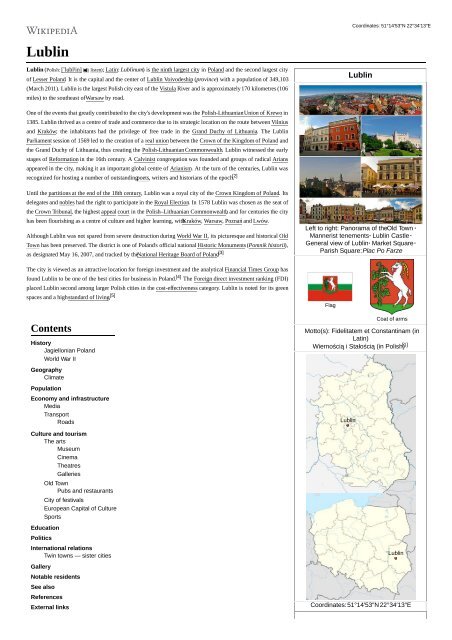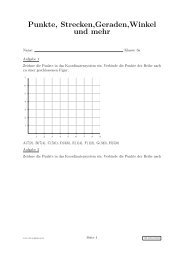pdf-zusammengefasst
Create successful ePaper yourself
Turn your PDF publications into a flip-book with our unique Google optimized e-Paper software.
Coordinates: 51°14′53″N 22°34′13″E<br />
Lublin<br />
Lublin (Polish: [ˈlublʲin] ( listen); Latin: Lublinum) is the ninth largest city in Poland and the second largest city<br />
of Lesser Poland. It is the capital and the center of Lublin Voivodeship (province) with a population of 349,103<br />
(March 2011). Lublin is the largest Polish city east of the Vistula River and is approximately 170 kilometres (106<br />
miles) to the southeast of Warsaw by road.<br />
Lublin<br />
One of the events that greatly contributed to the city's development was the Polish-Lithuanian Union of Krewo in<br />
1385. Lublin thrived as a centre of trade and commerce due to its strategic location on the route between Vilnius<br />
and Kraków; the inhabitants had the privilege of free trade in the Grand Duchy of Lithuania. The Lublin<br />
Parliament session of 1569 led to the creation of a real union between the Crown of the Kingdom of Poland and<br />
the Grand Duchy of Lithuania, thus creating the Polish-Lithuanian Commonwealth. Lublin witnessed the early<br />
stages of Reformation in the 16th century. A Calvinist congregation was founded and groups of radical Arians<br />
appeared in the city, making it an important global centre of Arianism. At the turn of the centuries, Lublin was<br />
recognized for hosting a number of outstanding poets, writers and historians of the epoch. [2]<br />
Until the partitions at the end of the 18th century, Lublin was a royal city of the Crown Kingdom of Poland. Its<br />
delegates and nobles had the right to participate in the Royal Election. In 1578 Lublin was chosen as the seat of<br />
the Crown Tribunal, the highest appeal court in the Polish–Lithuanian Commonwealth, and for centuries the city<br />
has been flourishing as a centre of culture and higher learning, with Kraków, Warsaw, Poznań and Lwów.<br />
Although Lublin was not spared from severe destruction during World War II, its picturesque and historical Old<br />
Town has been preserved. The district is one of Poland's official national Historic Monuments (Pomnik historii),<br />
as designated May 16, 2007, and tracked by the National Heritage Board of Poland. [3]<br />
The city is viewed as an attractive location for foreign investment and the analytical Financial Times Group has<br />
found Lublin to be one of the best cities for business in Poland. [4] The Foreign direct investment ranking (FDI)<br />
placed Lublin second among larger Polish cities in the cost-effectiveness category. Lublin is noted for its green<br />
spaces and a high standard of living. [5]<br />
Contents<br />
History<br />
Jagiellonian Poland<br />
World War II<br />
Geography<br />
Climate<br />
Population<br />
Economy and infrastructure<br />
Media<br />
Transport<br />
Roads<br />
Culture and tourism<br />
The arts<br />
Museum<br />
Cinema<br />
Theatres<br />
Galleries<br />
Old Town<br />
Pubs and restaurants<br />
City of festivals<br />
European Capital of Culture<br />
Sports<br />
Education<br />
Politics<br />
International relations<br />
Twin towns — sister cities<br />
Gallery<br />
Notable residents<br />
See also<br />
References<br />
External links<br />
Left to right: Panorama of the Old Town ·<br />
Mannerist tenements· Lublin Castle ·<br />
General view of Lublin· Market Square ·<br />
Parish Square: Plac Po Farze<br />
Flag<br />
Coat of arms<br />
Motto(s): Fidelitatem et Constantinam (in<br />
Latin)<br />
Wiernością i Stałością (in Polish) [1]<br />
Lublin<br />
Lublin<br />
Coordinates: 51°14′53″N 22°34′13″E


















